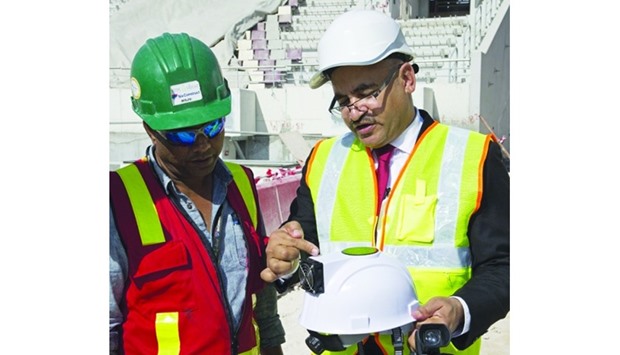This will allow for safer and more comfortable working conditions in the summer months, according to researchers working on the new system at Qatar University (QU), the SC posted on its website.
The solar-powered helmet has been rigorously tested, patented worldwide and put through the production stage by a group of Doha-based scientists in co-operation with the SC and Aspire Zone Foundation (Aspire). More units have now been ordered with the objective to incorporate them for the coming summer period across SC projects.
“We were approached by the SC and Aspire with a challenge, and our objective was to reduce heat stress and heat strokes for workers in Qatar and the region during the summer months. This type of body-based cooling technology has been used before in the US sports for training purposes in hot states, but we have now developed this innovative solution for the construction sector and we believe it has the potential to revolutionise the construction industry in hotter areas of the world,” said Dr Saud Abdul-Aziz Abdul-Ghani, Professor at the College of Engineering at QU.
The researcher who previously taught at British universities in Nottingham and Manchester has been working on the project for two years alongside a group of students from Qatar, Jordan, Greece and Egypt, and is co-operating closely with the SC and Aspire on the project in order to implement it on construction sites for the 2022 FIFA World Cup Qatar.
“Our concept is to use a solar-powered fan to blow air over a cooled material at the top of the helmet, which will then come down over the front of the person’s face and provide a cooler micro-climate for the worker,” Dr Abdul-Ghani told www.sc.qa
“We are confident that this technology will create more comfortable and safer working conditions, and there is just a minimal increase in weight to the helmet. By reducing the temperature of the head and face, the rest of the body will naturally follow and ensure that workers have a constant flow of cooler air to refresh them throughout their day.”
An additional weight of 300gm and a small solar panel attached to the helmet ensures that the new product is both safe and effective.
“As we continue to place workers’ welfare as a top priority across all our construction sites, we are working hard to find and develop the most innovative and advanced solutions in our preparations for the 2022 FIFA World Cup in Qatar,” said engineer Hilal Jeham al-Kuwari, chairman – Technical Delivery Office, SC.
Advanced testing has already taken place on the cooled helmet and the developers have pointed to a number of regions where the technology could also be applied once it goes into mass production.
“This type of innovative cooling technology will be ideal for the Middle East, Asia, Australia, Mexico and the US, all countries with hot climates where this technology can help reduce heatstroke and regulate body temperatures for construction workers significantly. Once we have finished development we can roll this out to the region and to other hot areas as part of the legacy of this tournament,” added Dr. Saud.
“This is an important initiative and we are proud to be involved in the development of this technology,” said Abdulaziz al-Mahmoud, deputy president for Sports Projects at Aspire Zone Foundation.
“Our participation in this project is a demonstration of our AZF’s vision to become the reference for sports excellence world-wide by 2020, and in line with our work values of innovation that we seek in all our projects.”
During the testing and development phases, a number of detailed studies were undertaken by QU, including testing the system in climatic chambers, analysing the amount of sweat per hour and adding the effect of sun, air, wind and measurement of the amount of heat that passed through the head. Further considerations in the development process were the weight and price of the cooled helmet, with as little weight and cost as possible being added in order to keep the innovative technology accessible.
“The material we use inside the helmet is Phase Changing Material contained in a pouch. This provides cooling in hot conditions for up to four hours straight. People when working in the sun will get cool air coming down at the front of their faces. When they go for a break, they throw it into a refrigerator and pick up a cold pack and put it into their helmets,” concluded Dr. Saud.
“We did research on the best areas to lower body temperature, and it was the head and face. The additional cost is just $20 in comparison to a normal passive helmet, but the results are felt immediately in terms of less lost time on site due to heat-related complaints.”



